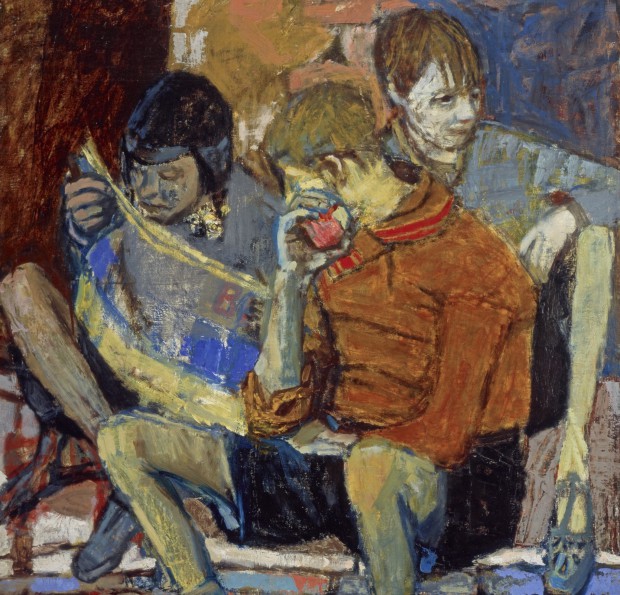Modern Scottish Men, a new exhibition celebrating the achievements of male artists in the 20th century, opens next month in Edinburgh. Men only; no women. Bold! Only joking. That show would never happen today. How could it? Where would an exclusive, specifically male-only exhibition be tolerated these days? A women-only show, on the other hand, would be fair enough; we need to point out that the wee dears can paint too. And so we have Modern Scottish Women: Painters and Sculptors 1885–1965. Should we perhaps be feeling patronised, ladies?
The recent death of Brian Sewell has again thrown up his old allegations regarding the inferiority of women artists. ‘Only men are capable of aesthetic greatness,’ he said, and the art market would appear to support his position by stoutly refusing to take any great interest in work by female artists. A Georgia O’Keeffe sold for $44.4 million last year, which seems a lot until you consider that two years previously, the market had seen fit to lavish $118 million on a thoroughly bland Modigliani.
Examine the catalogue of most expensive artwork. In February this year, somebody paid nearly $300 million for one of Gauguin’s Tahitian pieces. A length or two behind are Cézanne, Rothko, Picasso and Pollock. Painters of greater or lesser ability fall in below them but not one of them is female, until you reach O’Keeffe. It was not until 2004, more than 30 years since the bloated market began throwing millions at works by men, that something by a living female artist, Marlene Dumas, scraped $1 million at auction.
The market is only part of the story. It operates according to its own purpose, and is, evidently, no great arbiter of quality. What other mechanism would rank Barnett Newman above Titian? What is important, and what endures, is not the market value of an artwork but the work itself. The market merely skews perception among those who cannot be bothered to look for themselves.
John Berger summarised much of art history as crude objectification: ‘Men look at women. Women watch themselves being looked at.’ Simplistic though this is, when female artists began exhibiting paintings of male nudes it was considered a shocking inversion of tradition. A fine nude, awkward and emaciated, by Joan Eardley in the Modern Scottish Women show illustrates this progression; she presents a real man, closer to Egon Schiele than the heroic torsos of the Renaissance.
Beyond painting men as objects, the feminist response was to turn the lens, or canvas, on themselves. Judy Chicago and Suzanne Lacy led the way in the 1970s with tortuous performances of writhing naked women smeared in blood and muck, accompanied by audio accounts of rape. The work was born out of a determination to subvert the orthodoxy and to that extent it worked. The unfortunate outcome was not a greater respect for women artists, however, but a generation of art made by women that became depressingly solipsistic. The feminist artist maintains a profile in the public consciousness as a straight-fringed fury, sewing tampons on to bras. This disproportionate appreciation has been fed by media fixation on Tracey Emin’s bed and Sarah Lucas’s entire catalogue. Yet despite the female members of the YBA bubble, it is worth noting that only five of the 30 Turner Prizes have gone to women.
Women are sold short by artists who claim to speak on their behalf. They are, obviously, discrete individuals and the idea of women’s art as something homogenous is ridiculous. Nobody is a ‘good woman artist’, but either a good artist or a poor one. Brian Sewell was wrong to assert that there have been no great women artists, a claim he was far from alone in making. In truth, there have been very few great artists of either sex but certainly some of both. What was Artemisia Gentileschi if not a great painter? If the impressionists are to be classified as greats, Berthe Morisot and Mary Cassatt must stand among them. And Frida Kahlo was one of the most extraordinary of all.
Where women can be roughly grouped is in the obstacles they encountered. None of these — children, domestic obligation, historically limited access to formal education — is unique to art but they help to explain women’s diminished presence in galleries. Highlighting the impact of limited opportunities and the reaction of a sceptical patriarchal establishment to women’s art is a central element of the Modern Scottish Women show, and it is the necessary bit. The quality of work by these artists is not in doubt. Anne Redpath is an acknowledged leader of mid-century British art, while the work on display by Wilhelmina Barns-Graham compares favourably with any Ben Nicholson. The less illustrious artists are also compelling. Norah Neilson Gray and Bessie MacNicol may be unfamiliar to most visitors, but their paintings will impress with their tonal harmony and soft, painterly modelling.
Scotland has been particularly well furnished with female artists of outstanding ability but it is still worth explaining why women have been exhibited less than men, and appreciated below them. It is opportunity, not ability, that has held women back historically, something that Modern Scottish Women demonstrates with lucidity and confidence. The exhibition is not patronising; it is informative and revealing. The depressing thing is not that it exists but that, until everyone who shares Sewell’s prejudice has joined him through the pearly gates, it still needs to exist.






Comments